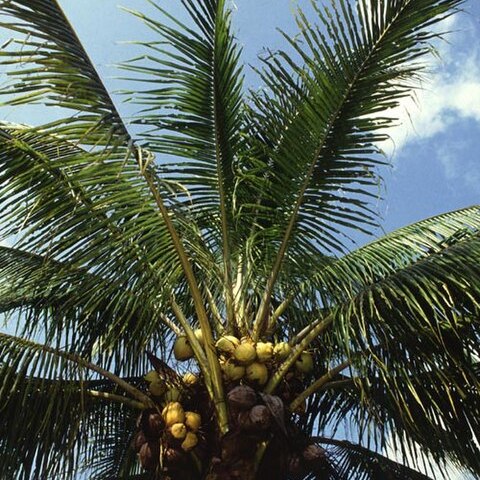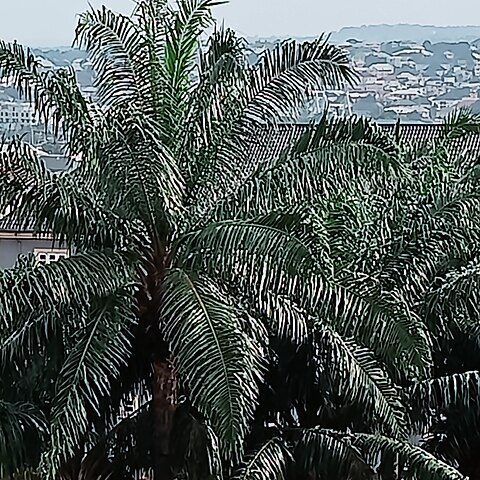Trees or shrubs [lianas], perennial, branched or unbranched, solitary or clustered. Roots adventitious, thick. Stems woody, subterranean or terrestrial, creeping or erect [climbing], slender or massive, sometimes conspicuously enlarged and storing starch and water, smooth or covered with fibrous or prickly remains of leaf bases. Leaves spirally arranged; sheaths tubular, often forming crownshaft, sometimes with ligular appendages; petioles terete, channeled, or ridged, unarmed or bearing prickles or marginal teeth; hastula (flap of tissue from petiole apex at junction with surface of blade) absent or present adaxially, rarely present abaxially. Leaf blade palmate, costapalmate (intermediate between palmate and pinnate), pinnate, or 2-pinnate [undivided]; plication (folding lengthwise into pleats or furrows) ^-or tent-shaped (reduplicate, splitting along abaxial ridges) or V-shaped (induplicate, splitting along adaxial ridges); segments lanceolate, linear, or cuneate [rhombic], glabrous or variously scaly, unarmed or bearing prickles (proximal segments modified into spines in Phoenix). Inflorescences from solitary [clustered] axillary buds, borne within, below, or above crown of leaves, paniculate, rarely spicate, usually branched to 1--5 orders; prophyll (1st bract on main inflorescence axis) 2-keeled; peduncular bract(s) (empty bract[s] between 1st prophyll and 1st bract subtending branch) present [absent]; flowers bisexual, unisexual with staminate and pistillate on same plants or on different plants, or both bisexual and unisexual on same plant. Flowers solitary or variously clustered along rachillae of inflorescence, radially symmetric; perianth 1--2-seriate; sepals [2--]3[--4], distinct or connate; petals [2--]3[--4], distinct or variously connate; androecium: stamens [3--]6--34[--1000]; filaments distinct or connate or basally adnate to petals; anthers basifixed or dorsifixed, dehiscing latrorsely or introrsely; staminodes in pistillate flowers distinct or variously connate or adnate to pistil or petals; pistils 1 or 3, distinct or partially connate, each bearing 1 ovule and 1 stigma, or 1 pistil bearing 1--3 ovules and 3 stigmas; styles distinct or connate, short; stigmas dry; pistillode in staminate flower present or absent. Fruits drupaceous or berrylike; stigmatic remains basal or apical; exocarp smooth, warty, prickly, or hirsute [corky or scaly]; mesocarp fleshy or dry and fibrous; endocarp papery, leathery, or bony, sometimes with 3 germination pores. Seeds 1(--2+), free or adhering to endocarp; seed coat thin; endosperm homogeneous or ruminate, sometimes penetrated by seed coat; embryo basal, lateral, or apical, peglike, minute; eophyll (1st seedling leaf with blade) undivided and lanceolate or 2-cleft [pinnate].
Stems solitary or clustered, short and subterranean, erect, or climbing. Leaves pinnate, palmate, or costapalmate, spirally or rarely distichously arranged, sometimes spiny; sheaths usually open, sometimes closed and forming crownshafts, in climbing plants usually with knees and sometimes with flagella; petioles short or absent to elongate, smooth, spiny, in palmate leaves with a hastula at apex, rarely hastula absent; rachis short to elongate, absent in palmate leaves, sometimes extended into a whiplike climbing organ (cirrus); pinnae in pinnate leaves either regularly or irregularly arranged along rachis, spreading in 1 or several planes, variously shaped, mostly reduplicate, rarely induplicate, sometimes jagged or lobed at apices, rarely gray abaxially; segments in palmate leaves variously arranged, single or multi-fold, split to varying degrees, mostly induplicate, rarely reduplicate. Plants monoecious, sometimes dioecious, iteroparous (pleonanthic) or less often semelparous (hapaxanthic). Inflorescences borne among or below leaves, solitary or rarely multiple at each node; peduncle bearing a prophyll and usually 1 or more peduncular bracts; rachis bearing prominent or much-reduced rachis bracts; rachillae 1 to many, bearing flowers in various arrangements, often solitary, paired, in threes (triads) or more; flowers usually with 3 sepals, 3 petals, 6 stamens, and 3 carpels. Fruits variously shaped and colored, sometimes covered with overlapping scales; endosperm ruminate or homogeneous; germination remote or adjacent; eophylls undivided, bifid, pinnate, or palmate.
Small to tall plants, monoecious or dioecious, polygamous, polygamodioecious, polygamomonoecious, and hapaxanthic or pleonanthic. Stems solitary or clustered, acaulescent (not in Australia), erect or climbing, slender to stout; leaf scars annular. Leaves forming a terminal crown, palmate, costapalmate, paripinnate, imparipinnate, bipinnate, or entire. Inflorescence axillary, infrafoliar, interfoliar or suprafoliar, spicate or paniculate, bearing papery to woody, deciduous or persistent bracts; single prophyllar bract always present, proximal on inflorescence, bicarinate, variously shaped; peduncular bracts 0–many, bicarinate or tubular, distal to prophyll, variously shaped. Flowers unisexual or bisexual, ebracteate; perianth of usually dissimilar sepals and petals, usually trimerous; segments fused or free, valvate or imbricate, usually thick textured and dull-coloured; stamens 3, 4, 6 or numerous; gynoecium apocarpous with 1–3 carpels or syncarpous with 3 or sometimes more locules, or pseudo-monomerous; ovary superior, smooth or covered in imbricate scales. Fruit a berry or drupe, small to large, 1–3-seeded, or to 8 seeded (not in Australia); epicarp smooth, warty, corky (not in Australia), scaly or spiny (not in Australia), usually brightly coloured; mesocarp fibrous, fleshy or dry, or obsolescent; endocarp thin, thick or absent. Seed adhering or not adhering to endocarp, sometimes sarcotestal; endosperm ruminate (due to infolding of seed coat) or homogeneous, rarely with central cavity; embryo small. Eophyll simple, bifid or compound.
Leaves in a terminal cluster or in the climbing species scattered, sometimes very large, entire, pinnately or digitately divided, the segments or leaflets folded induplicately or reduplicately in bud, often sharp at the apex and prickly on the margins or midrib; rhachis often expanded at the base into a fibrous sheath
Ovary superior, rudimentary or absent in the male flowers, 1-3 locular, rarely 4-7 locular, or carpels 3 and distinct or connate only at the base; ovule solitary and erect or pendulous from the inner angle of each carpel or loculus of the ovary
Stems stout or slender, sometimes climbing, sometimes very short or almost nothing, often covered by the persistent bases of the leaves; primary root soon disappearing and replaced by roots from the base of the stem
Flowers small, actinomorphic, bisexual, monoecious or dioecious, sometimes polygamous, arranged in an often paniculate inflorescence (spadix) either amongst or below the leaves
Spathes various, sometimes numerous and enclosing the peduncle and branches of the inflorescence, or few, leathery or membranous; bracteoles often connate below the flowers
Stamens usually 6, in two series, rarely numerous; anthers 2-locular, loculi globose to linear, opening by slits lengthwise; pollen smooth or rarely echinulate
Fruit a berry or drupe, 1-2-locular, or fruiting carpels distinct; exocarp often fibrous, sometimes covered by reflexed scales
Petals 3, separate or connate, usually valvate in the male flowers and imbricate in the female
Seeds free or adherent to the endocarp; endosperm present, sometimes ruminate; embryo small
Sepals 3, separate or connate, imbricate or open in bud
Perianth double



